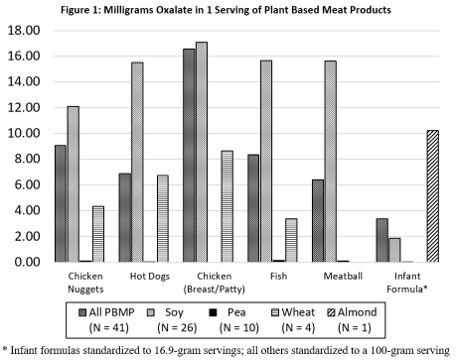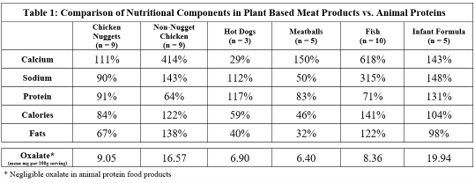Back
Poster, Podium & Video Sessions
Moderated Poster
MP17: Pediatric Urology: Upper & Lower Urinary Tract
MP17-10: Increased Lithogenic Risk in Plant-Based Meat Products for Children and Infants
Friday, May 13, 2022
4:30 PM – 5:45 PM
Location: Room 225
Garrett Ungerer*, Christine Liaw, Aaron Potretzke, David Sas, Patricio Gargollo, Candace Granberg, Kevin Koo, Rochester, MN

Garrett Ungerer, MD
Mayo Clinic - Rochester
Poster Presenter(s)
Introduction: The global prevalence of pediatric nephrolithiasis continues to rise amidst increased sodium and animal protein intake. Recently food products made from plant-based meat products (PBMPs) have gained popularity due to perceived health benefits, social and environmental concerns, increased retail availability, and direct marketing to parents and children. We analyzed PBMPs targeted to children to characterize potential lithogenic risk vs animal protein.
Methods: We performed a dietary assessment using a sample of PBMPs marketed to or commonly consumed by children and commercially available at national retailers. Nutrient profiles for PBMPs were compiled from US Department of Agriculture databases and compared to animal protein sources using standardized serving sizes. We also analyzed nutrient profiles for plant-based infant formulas against typical lactose-based formulas. Primary protein sources were identified using verified ingredient lists. Oxalate content was extrapolated based on dietary data sources.
Results: A total of 41 PBMPs were analyzed: chicken (N=18), hot dogs (N=3), meatballs (N=5), fish (N=10), and infant formula (N=5). Most products (76%) contained a high-oxalate ingredient as the primary protein source (soy, wheat, or almond). Average oxalate content per serving was substantially higher in these products (soy 11.6 mg, wheat 3.8 mg, almond 10.2 mg) vs animal protein (negligible oxalate) (Figure 1). PBMPs containing pea protein (24%) had lower average oxalate (0.11 mg). Most PBMPs averaged up to six times more calcium and three times more sodium per serving compared to their respective animal proteins, but less protein content overall (Table 1).
Conclusions: Three-quarters of plant-based meat products for children and infants contain high-oxalate protein sources. Coupled with higher per-serving sodium and calcium amounts, our findings suggest potential increased lithogenic risk of these foods with implications for pediatric nephrolithiasis.
Source of Funding: None


Methods: We performed a dietary assessment using a sample of PBMPs marketed to or commonly consumed by children and commercially available at national retailers. Nutrient profiles for PBMPs were compiled from US Department of Agriculture databases and compared to animal protein sources using standardized serving sizes. We also analyzed nutrient profiles for plant-based infant formulas against typical lactose-based formulas. Primary protein sources were identified using verified ingredient lists. Oxalate content was extrapolated based on dietary data sources.
Results: A total of 41 PBMPs were analyzed: chicken (N=18), hot dogs (N=3), meatballs (N=5), fish (N=10), and infant formula (N=5). Most products (76%) contained a high-oxalate ingredient as the primary protein source (soy, wheat, or almond). Average oxalate content per serving was substantially higher in these products (soy 11.6 mg, wheat 3.8 mg, almond 10.2 mg) vs animal protein (negligible oxalate) (Figure 1). PBMPs containing pea protein (24%) had lower average oxalate (0.11 mg). Most PBMPs averaged up to six times more calcium and three times more sodium per serving compared to their respective animal proteins, but less protein content overall (Table 1).
Conclusions: Three-quarters of plant-based meat products for children and infants contain high-oxalate protein sources. Coupled with higher per-serving sodium and calcium amounts, our findings suggest potential increased lithogenic risk of these foods with implications for pediatric nephrolithiasis.
Source of Funding: None



.jpg)
.jpg)